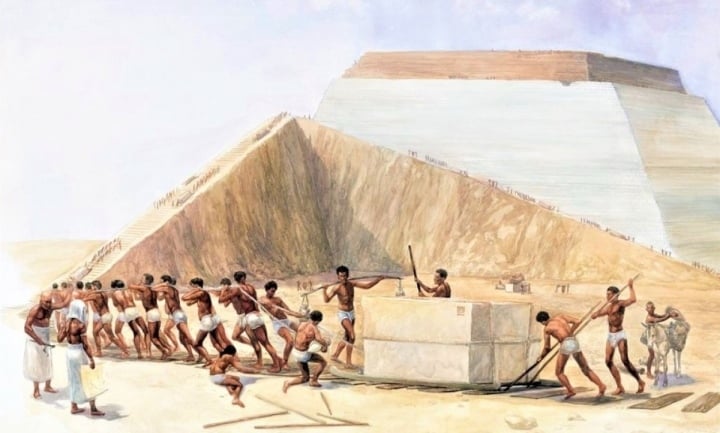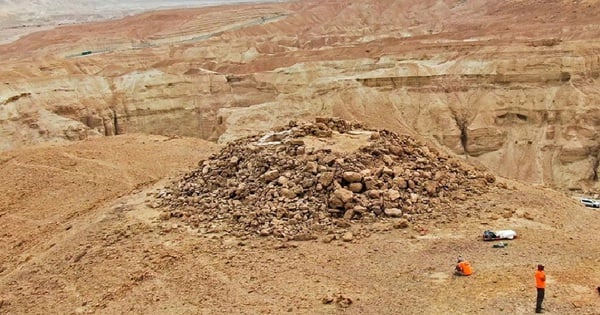The pyramids of Egypt are archaeological wonders, rising high above the desert sands and visible for miles. Building them was certainly a mammoth task, so how were they built?
How were the pyramids built?
The question of how the ancient Egyptians built the pyramids has puzzled experts for centuries, according to an article in Dan Tri Newspaper. But the latest research has uncovered clues to a much simpler method. Specifically, the research team found a dried-up branch of the Nile River that led directly to the Great Pyramid 4,500 years ago.
The research, published in the Proceedings of the National Academy of Sciences, explains how ancient people moved millions of tons of stone across 6.5km of land once mistaken for a dry desert.
"It would have been impossible to build the pyramids without the small branch of the Nile," the researchers said.
To find this branch of the Nile, the team had to dig holes in the desert around the pyramid to search for ancient pollen, which is the pollen of plants that thrive in water.
The results showed that this small river had long since disappeared. While the pollen of the plants that once lived in the river had been depleted for centuries by the time King Tutankhamun came to power, that was around 1350 BC.
In fact, before finding traces of the once-dried Nile, experts had already predicted a method of using waterways to transport stones.

A 4,500-year-old papyrus discovered in 2013 contains detailed records of the construction of the Great Pyramid. The log, written in hieroglyphics, records various activities related to the construction of the Giza pyramids and work at a limestone quarry on the other side of the Nile in a timetable format.
It describes the structure as nearly complete. The remaining work focused on building the outer limestone casing of the pyramid. Workers quarried the stone in Tura, near modern-day Cairo. They transported the huge blocks of stone to the pyramid by boat along the Nile and a system of canals.
The Egyptian pyramids were built by hundreds of thousands of slaves?
VOV newspaper quoted Historyofyesterday as saying that our thoughts about the ancient world, including the belief that the pyramids were built by slaves, are completely wrong.
The pyramids, the world's largest structures until the 20th century, were not built by slaves. The three pyramids of Giza, built in the third millennium BC, represent the best of ancient Egypt's pyramid-building skills.
Identifying who built them has been called “one of the most important archaeological discoveries in the last 100 years.” During an excavation around the Giza pyramids, an excavator hit a large block that was the wall of a building. Archaeologists explored and found the large structure – a village, dating back to 2,000 BC. The village spanned more than half a square mile.
It has been determined that these were the houses where the pyramid builders lived and worked. Large intact bakeries were also found in the village. They were filled with hundreds of large clay pots in which bread was baked, weighing up to 25 kg. The large clay pots are the first indications of the production of the amount of bread needed to feed a large workforce.
The chief archaeologist of the Giza plateau, Dr. Zahi Hawass, explains how the second clue came when a woman was riding a horse and the horse's foot fell into a crack that revealed a wall built of bricks and mud.
These are the walls of the tombs of the pyramid builders and their supervisors. 600 of these tombs have been discovered divided into two levels. The lower level tombs are very simple and contain only the bones, pots and tools of the workers.
The “upper” tombs were more elaborate and contained the burials of the supervisors and architects. The tombs were completely intact as robbers did not bother with them as they were believed to contain no treasures. The walls of some tombs were inscribed with inscriptions. The inscriptions explained the process of pyramid building as well as the cooking, planning and direction that was involved in the whole operation.
The bones in the tombs were then moved to the Cairo University School of Medicine, where more groundbreaking discoveries were made. Of all the skeletons, 50% were male, 50% were female, and 23.6% belonged to children (even as young as one year old). This suggests that entire families of construction workers lived around the pyramids.
DNA analysis confirmed that theory. The discovery of family life destroyed the theory that slaves built the pyramids, and subsequent discoveries have debunked that theory once again.
After further analysis of the bone fragments, scientists discovered how some of the bones were broken and then healed. The researchers compared the healed bones of the workers with similar healed bones of the nobles and found that the victims received similar medical care.
Healing broken bones in ancient Egypt required a great deal of skill and time that was not available to slaves. But pyramid workers received that special treatment.
Although the pyramid builders were treated well, their lives were not easy. They lived 10 years shorter than the nobility and their bent bones show signs of high stress.
However, it did not take 100,000 workers and 30 years to build the pyramids. Especially since 100,000 people is equivalent to 10% of the population of ancient Egypt. In fact, it took ancient Egypt only 20,000 people and 20 years to build the Great Pyramid of Giza, which consists of 2.3 million stone blocks weighing up to 10 tons each.
Of those 20,000 workers, 15,000 of them work 12 hours a day for three months and then return to their villages. New workers will replace them. The remaining 5,000 are permanent key workers and technicians.
By conducting a large-scale experiment, American construction expert Craig Smith, who built airports and subways, confirmed those numbers. Thus, the theory of using slaves and in numbers to build the pyramids was proven to be completely wrong.
Ha Anh (Synthesis)
Useful
Emotion
Creative
Unique
Wrath
Source


![[Photo] Prime Minister Pham Minh Chinh receives Deputy Prime Minister of the Republic of Belarus Anatoly Sivak](https://vstatic.vietnam.vn/vietnam/resource/IMAGE/2025/4/2/79cdb685820a45868602e2fa576977a0)
![[Photo] Comrade Khamtay Siphandone - a leader who contributed to fostering Vietnam-Laos relations](https://vstatic.vietnam.vn/vietnam/resource/IMAGE/2025/4/3/3d83ed2d26e2426fabd41862661dfff2)
![[Photo] General Secretary To Lam receives Russian Ambassador to Vietnam](https://vstatic.vietnam.vn/vietnam/resource/IMAGE/2025/4/2/b486192404d54058b15165174ea36c4e)

![[Photo] Prime Minister Pham Minh Chinh receives CEO of Standard Chartered Group](https://vstatic.vietnam.vn/vietnam/resource/IMAGE/2025/4/2/125507ba412d4ebfb091fa7ddb936b3b)




























































































Comment (0)